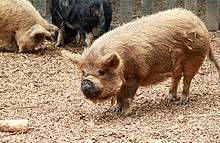Kunekune
The kunekune /ˈkuːnɛkuːnɛ/[1] is a small breed of domestic pig from New Zealand. Kunekune are hairy with a rotund build, and may bear wattles hanging from their lower jaws. Their colour ranges from black and white, to ginger, cream, gold-tip, black, brown and tricoloured. They have a docile, friendly nature, and are now often kept as pets.
 Kunekune at the Hamilton Zoo | |
| Conservation status | Rare |
|---|---|
| Country of origin | New Zealand |
| Traits | |
| |
History
The breed is believed to have descended from an Asian domestic breed introduced to New Zealand in the early 19th century by whalers or traders. They differ markedly from the feral pig of European origin known in New Zealand as a "Captain Cooker".[2] The native Māori people of New Zealand adopted kunekune; kunekune is a Māori-language word meaning "fat and round".[3]
By the 1980s, only an estimated 50 purebred kunekune remained. Michael Willis and John Simister, wildlife-park owners, started a breeding recovery programme, which encouraged other recovery efforts. As of 2010, the breed no longer faces extinction, with breed societies in both New Zealand and the United Kingdom. In 1993, two were imported into the United States from the UK.
Appearance
The kunekune is covered in hair which can be long or short, and straight or curly. Hair colours include black, brown, ginger, gold, cream, and spotted combinations. It has a medium to short slightly upturned snout that is black and either semilopped or pricked ears. It has a short, round body with short legs and may have two wattles (called piri piri) under its chin. The kunekune stands about 60 cm (24 in) tall. An adult kunekune can weigh between 60 and 200 kg.[4]
Habitat
The natural habitat for kunekune is woodland and pasture. They thrive in the outdoors.
Diet
Kunekune are very easy to manage, as they have the ability to live on little more than grass. They are the only true grazing pig, and can be maintained with mostly grass with a little supplementary feeding. One acre of grass can sustain as many as six kunekune.
Breeding
Kunekune boars become fertile at six to seven months, while the gilts can become pregnant at five months. However, gilts are not normally mated to the boar until they are a year old. The sows are good mothers, and the litters vary in size averaging around seven piglets.
References
- kunekune - Māori Dictionary
- "Captain Cooker" Archived 2010-09-05 at the Wayback Machine, Te Ara Encyclopedia of New Zealand
- "About Kunekunes". Archived from the original on 2019-03-29. Retrieved 2019-03-29.
- The New Zealand Kunekune Association. ""Miniature" kunekune pigs". The New Zealand Kunekune Association. Archived from the original on 2016-06-12. Retrieved 2015-08-07.
External links
| Wikimedia Commons has media related to Kunekune. |